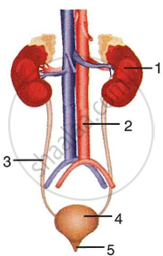Advertisements
Advertisements
प्रश्न
Given alongside is the figure of certain organs and associated parts in the human body. Study the same and answer the questions that follow:
 |
- Name all the organ systems shown completely or even 3 partially.
- Name the parts numbered 1 to 5.
- Name the structural and functional unit of the part marked '1'.
- Name the two main organic constituents of the fluid that flows down the part labelled '3'.
- Napie the two major steps involved in the formation of the fluid that passes down the part labelled '3'.
उत्तर
- Urinary system.
-
- kidney
- Aorta
- Ureter
- Urinary bladder
- Urethra
- Nephron or uriniferous tubule.
- Urea and uric acid as urine.
- Ultrafiltration and reabsorption.
APPEARS IN
संबंधित प्रश्न
Name the following:
Cortical portions projecting between the medullary pyramids in the human kidney.
Define the following:
Excretion
What is a uriniferous tubule? How does it function?
Given below is the figure of certain organs and associated parts in the human body. Study the same and answer the question that follow:
Name the structural and functional unit of the part marked '1'.

Explain the Term: Urinary bladder
Give Technical Term:
Name the organ in which urine is stored before its elimination from the body.
Multiple Choice Question: What is the chief nitrogenous waste in mammals?
Name the process and the organ which helps in removing the following wastes from the body.
- Carbon dioxide
- Undigested food
- Urine
- Sweat
Read the following terms given below.
root hairs xylem urethra arteries kidneys veins atria capillaries heart ureter phloem urinary bladder
Group the terms on the basis of the categories given below.
(a) The circulatory system of animals.
(b) Excretory system in humans.
(c) Transport of substances in plants.
The inner visceral layer of glomerular capsule composed of specialised cells called ______.
